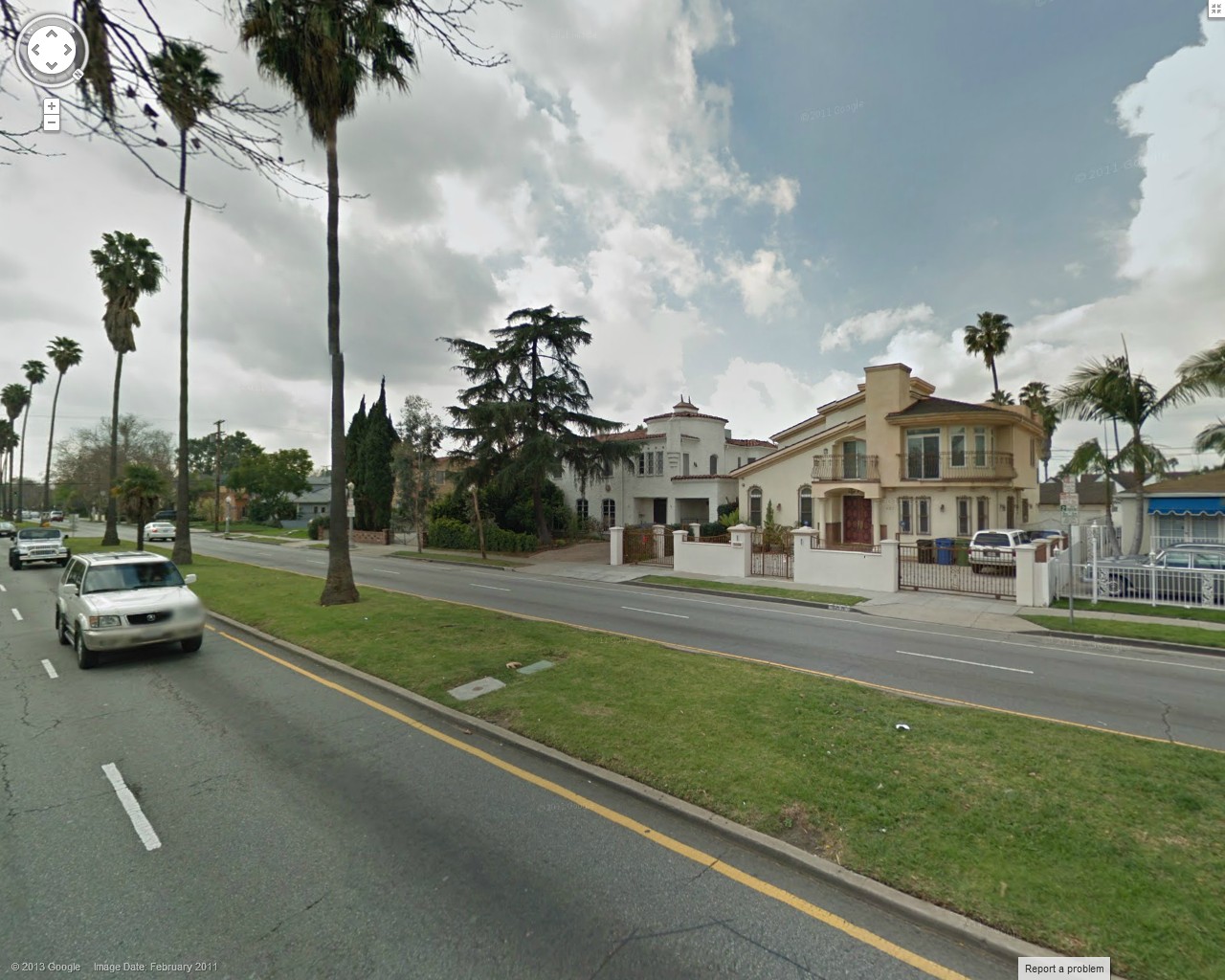 |
Old Bull Lee A Voice From the Reality-based Community Notes from a Study of Things Themselves |
 |
Eyewitness Account - Michael Hasting Car Crash
Journalist Michael Hastings was killed in a fiery car crash June 18, 2013 at about 4:15 in the morning in Los Angeles. Below is a transcript of a telephone interview with a woman who was awakened by that crash and who observed all activity at the crash scene for the next three hours. A video of the interview can be found at this July 19, 2013 posting at the Infowars.com website. The interview is also on Youtube.
Related Posting: Michael Hastings' Last Ride
The woman is not identified by name. We refer to her here as "Mrs. A." From her remarks in the interview, we know that on the day of Michael Hastings' death, she lived at one of these residences on North Highland Avenue in Los Angeles.

Michael Hasting died when his Mercedes C250 coupe crashed into the palm tree in the center-left of the picture above.
Note the two flat valve covers in the grassy median. Presumably they provide access to below-ground water pipes. At the time of Michael Hastings' crash, there was an above-ground pipe fixture, about two feet tall, that connected to those underground pipes. Michael Hastings ran over that fixture milliseconds before he crashed into the tree, shearing off a pipe such that water gushed out, four feet into the air. The witness, in her interview, calls the fixture a "hydrant."
The above-ground pipe fixture does not appear in the Google street-view image, which is dated February 2011. So it must have been installed between then and June 2013, when the crash occurred.
Gigi Erneta: I'm Gigi Erneta reporting for Infowars Nightly News and today I have a witness that was not necessarily at the scene of the Michael Hastings accident but at the scene after it happened. So I thank you so much for being here with me today.
Mrs. A: Thank you.
GE: I really wanted to ask you some questions about the crime scene and what you were able to see. I understand that you were inside the house because you were not allowed to be outside. The police made you stay in the house. Can you tell us a little bit about that?
Mrs. A: Well, we were at the scene right when it happened, right after impact because we were woken up. It was right in front of our house and we were outside up until the coroner got to the scene and at that point we were asked to go inside. So I went inside and I then went on my balcony which was facing the street and they asked me to go from my balcony into the house so I was able to observe it from the window.
GE: That's actually a pretty decent view, right, because you're above everything.
Mrs. A: Yes. Exactly. It was a good view. They were trying to spread the white linens from the coroner's office to block my view but nevertheless I had the (?) I could see pretty much everything.
GE: OK, well, let's start from the beginning. You were asleep when it happened. What did it sound like? And was there any light coming through the windows?
Mrs. A: My bedroom window faces the scene and my bed is right under that window. So I was woken up with a loud bang or boom simultaneous with the big flash -- huge flash. My whole room was like daylight even through the curtains. Before I got out of bed I moved the curtain and I saw what I assumed was the car. I couldn't even see that it was a car but I assumed it was a car completely engulfed in flames.
GE: So you heard what sounded like a boom. Did it shake the house at all?
Mrs. A: Not that I remember. No. It didn't shake the house. It was a boom and flash and we both, me and my husband, both jumped out of the bed. He put on his slippers and ran downstairs and screamed to me, "call 911." And oh, he -- by the time I put on my robe and came out -- he had turned on the hose and was trying to put the flames down.
GE: So, when you heard the boom, you jumped out of bed. It's just a few seconds and you went to the window -- it was already on fire? Right?
Mrs. A: It was on fire simultaneously with the impact.
GE: OK. How big would you say the fire was?
Mrs. A: As big as you see it on all the videos you see on Youtube and everywhere. It was like this from the start. It started like that.
GE: So instantaneously there was fire?
Mrs. A: Instant.
GE: OK. So, as time passed how long did it take for the fire department and the police to get there?
Mrs. A: From my call to the fire department it was between three and four minutes.
GE: Which is pretty fast for LA.
Mrs. A: Very fast.
GE: So maybe tops, five minutes. What was the first thing they did when they got there?
Mrs. A: Uh, the first--while they were pulling (?) their equipment and rolling their hoses. One of the firemen looked into the drivers side and you can see him on the videos where he thinks there is no rush; whoever is there -- it's too late to save him. At that point there was no rush in their movements. It took about thirty seconds with their hoses to put the fire out [but] they saw they were not saving anybody.
GE: Did you see anything in the car at that point? Could you see from your view?
Mrs. A: Absolutely could not see. When I called 911 they asked me, "Could you see anyone in the car?" I said, "I cannot see anything in the car. The car itself is a ball of flame."
GE: So when the police got there, the firemen were there. They were trying to put the fire out. Tell us a little bit about when the coroner got there.
Mrs. A: OK. the coroner got there at 7:30. That was three hours after the accident. And there were two cars: a regular car and a van. There were two lady coroners. One was coroner investigator and one was just a coroner. There were signs on their backs. One was oriental and one was latina. They were slight ladies. I was thinking: how are they going to do this task.
At that point there was fire department on the scene, but not the one that put out the fire. It was another fire department that was -- that had equipment to cut the car -- the jaws of life and chains and all kind of stuff like that. What they did was they first cut out -- I think they had their generator with them -- they plugged in their tools. They cut out what was left of the front bumper and the back and the side panel from the driver side. Then they chained the front of the car to the palm tree and the back of the car to the fire truck. They backed the fire truck to unfold the car like an accordion and then they got to cut him out. Two firemen got him out. And at that point the coroner took over the body.
GE: OK. so back to getting the jaws of life out. You said they had to basically saw into the car. When the fire was finally put out and I guess they got it completely out before they started....
Mrs. A: No, No. 4:30 is the time of the accident. When the firemen got to the scene, the fire is put out in 30 seconds. So by 4:35 the fire was out. The coroners are on the scene three hours later. The body was in the car for three hours. For those three hours a bunch of police cars and detectives and supervisors and the police were all around the block, measuring, taping, taking pictures, taking videos, a separate photographer from the police, taking pictures from all kinds of angles. There was a detective who was not in police uniform there supervising the whole thing. There was a supervisor in police uniform supervising the policemen. For three hours they were working on that. Before they even touched the body.
GE: Now, when you were looking at this whole scene, there was a lot of debris. I know it's not in video. How far would you say the debris went? Would you say it went from Melrose down to Clinton, which is the street at the end of the block?
Mrs. A: The debris went down to Clinton. The transmission was in the corner with Clinton.
GE: Did that strike you as strange that it went that far?
Mrs. A: Not at that point, but looking back, absolutely.
GE: Two people....
[Male voice]: For me it was strange.
Mrs. A: My husband is on a completely different angle of the story.
[Male voice]: I didn't think it was strange at all. If a car is flying from north to south and its debris, its car parts, will spray from north to south.
GE: On Highland, right?
[Male voice]: The car parts went in one way.
GE: In one direction.
[Male voice]: The way the car was driving -- in the same way all the parts were flying.
GE: Were you able to see any kind of debris trail from the engine/transmission piece that was near Clinton? Was there a trail?
Mrs. A: No, it wasn't.
[Male voice}: It flied. All the time it was flying.
Mrs. A: Nothing dragged. It flew.
[Male voice]: Probably transmission. It was flying because it was very small and it's probably from the forces. It was skidding on the (?).
Mrs. A: There were no signs of skidding anywhere in the street. That's why I disagree.
GE: I was there and I noticed there were no marks on the street itself. No marks on the curb. It was fascinating. There wasn't even a crack on the curb. The water pipes that were there before, those were broken. And I guess you could see where they had been severed.
Mrs. A: He knocked down the fire hydrant and the box...there was a metal box around it, standing about two feet up and that was completely mangled. And that frame was also on the corner of Clinton.
GE: And you say it was mangled?
Mrs. A: Completely. yeah. Like screwed to metal (?). It was like made the metal chain-link kind of thing and it was completely destroyed.
[Male voice]: Security box.
Mrs. A: Kind of like a security frame for that hydrant. So that was completely bent -- bent out of shape.
GE: Some of the footage that's there from that night shows the car, the front end of the car. Some of it is already -- it looks like it's missing. Obviously it's on fire -- before they put that sheet and everything over it. Did you see anything in front of the car? Like a tire?
Mrs. A: OK. What was missing. Actually, I did not leave the scene so if you think somebody took something away from the scene, No (?). So everything that's there is there. Nobody took any parts of the car and put it away. I was there from the minute it happened until they towed the car away.
GE: So when they got the jaws of life out, they sawed in the door in the left side, the driver's side, but they didn't do anything else to the other side. Then they pulled it apart with the fire truck.
Mrs. A: They cut it apart. All the police pictures were taken before that.
GE: And then they got Hastings out of the car. Tell us a little about that.
Mrs. A: OK. So when I tell about that I have to preface it with the fact that they were trying their best not to let me see it. So whatever I did see, it was hard to see. What I expected to see -- after that fire -- basically was a body in pieces and completely black. So I saw his full body with a completely black face. completely burned face up to the shoulders. From shoulders down I saw the whole body which was completely intact, not burned in any way. I didn't know who it was but when I saw it, I told my daughter it was white guy about 25 - 30, I told her. A white, young guy. And I'm still doubting I could see it, but how did I know it was a white guy 25 - 30 with completely white arms -- not burned in any way. And from what I saw he was wearing something like a T-shirt, but I saw the gray color, but it could have been gray from the smoke. I don't know what its (?) is. As far as I could see, it was cut-off sleeves. I saw full white arms. I even paid attention that it was -- I thought to my self: it is California and the guy is so white, so not-tanned. But it was a dead body.
GE: It was sevenish when all this happened?
Mrs. A: it was 7:20 to 7:40.
GE: So you had pretty good daylight at that point?
Mrs. A: it was completely light. And so they put him on the grass. They spread the white sheet on the grass. Put him flat on his back and the coroners went around doing what they were doing. I could see they were kneeling in front of him, squatting in front of him. The two coroner ladies. And then one of them pulled him by the arm to lift him on his side. To roll him on his side and checked something in the back, which I assumed is the back pocket of his pants to see for ID. So I clearly saw not only was his skin not burned -- you could have moved him by the arms.
GE: But they found his ID in his pocket?
Mrs A: Did they find it? I don't know. I saw the movement of the body being rolled on the side, being pulled by one of the arms. And one of the coroners going into the back of the lower part of his body. It looked to me like the back pocket. Were they looking for ID? That was my assumption.
GE: Right, right. I want to thank you so much for allowing us to talk to you.
Mrs. A: Absolutely.
GE: And God bless you.
Mrs. A: Thank you.
GE: Thank you.
GE: And that was a witness from the Michael Hastings scene. So that's a lot to think about there. I'm Gigi Erneta. And this is Infowars Nightly News.